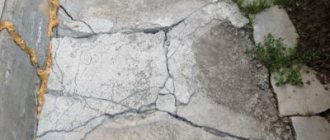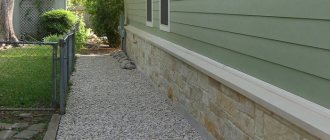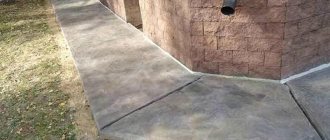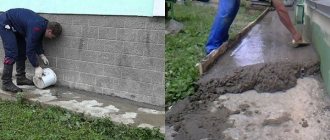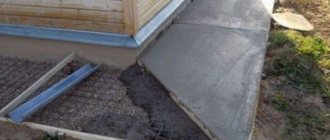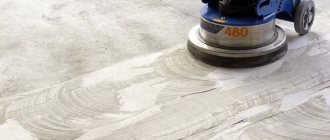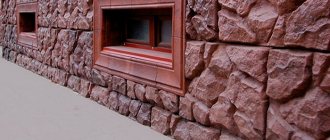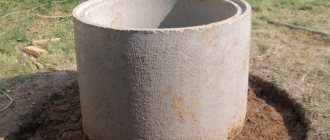The strength of concrete, as well as its vulnerability, under the influence of a certain set of circumstances, a cumulative combination of certain factors, is a fact known to both developers and ordinary people.
The choice of concrete as the leading material, which has excellent load-bearing abilities, implies special specific precautions that can prevent premature destruction of the structure or part of it.
Ironing a concrete blind area is one of these methods, proven by many years of practice, reliable, but encountering discrepancies in the method of implementation among specialists.
What it is?
Ironing is a technology specially developed by specialists for construction needs for surface treatment of reinforced concrete structures or their individual segments, for:
- giving increased strength;
- increasing the ability to withstand destructive influences;
- extending the period of trouble-free guaranteed operation.
A complex three-part term denotes the procedure of coating the surface of a monolith with variable compositions, which can significantly increase strength and the ability to prevent destruction. This process can be carried out independently by the developer.
Subject to the correct selection of the composition (it depends on the goals pursued and the segment on which ironing is performed), scrupulously observing all the conditions specified in the instructions from the manufacturer.
The procedure is almost always performed when it comes to:
structures subject to constant loads - dynamic, vibration, temperature or natural;- concrete paths that deteriorate or wear out over time;
- any coatings that may be exposed to natural influences - winds, precipitation, excessive solar radiation, fungi or mold from permanent humidity.
Ironing can be carried out on a new surface and on an old one. After cleaning from contaminants, it allows you to eliminate chips and cracks, although it does not return the previous optimal properties. In both the first and second cases, the technology is quite accessible for independent implementation.
Ironing is used only for blind areas made of concrete. When using the right technology, it always gives optimal results .
Why do blind area defects occur?
To make a strip around the perimeter of the building, materials such as concrete, cement, paving stones, natural and artificial stone are used. The first option is the most common. Asphalt and some other materials are rarely used. But sooner or later any blind area begins to collapse.
Defects appear in the form of deep or superficial cracks, displacement and subsidence of individual fragments, crumbling of individual edges or areas. It is also possible for the tiles to peel off from the base of the object. Before strengthening this strip, it is necessary to identify the reasons why it is subject to destruction:
- Incorrect installation technology. These include the lack of a waterproofing layer, lack of compaction and unevenness of the backfill, and non-compliance with standards for width and depth. Perhaps the work was carried out in the hot season, before rains or early frosts - all these factors affect the uncured solution. There is also a possibility that the correct recipe for the concrete composition was not followed, for example, a lot or little binder was added: in the first case, the surface will crack, and in the second, it will crumble.
- Lack of damping layer. Expansion joints are located between the slab and the base, becoming a shock absorber and contributing to the correct distribution of the resulting vibrations. Their absence will increase the risk of defects appearing on the blind area.
- Making a strip around the perimeter of the building without tilting towards the outside. Rain moisture stagnates on flat surfaces, which negatively affects artificial stones and cement coatings. A slight slope away from the object will allow water to drain naturally. Without it, small cracks will form, which will eventually turn into deeper tears.
- There is no reinforcement in the concrete blind area. This procedure is not mandatory according to current standards, but it gives the water drainage strip the necessary strength.
Methods for protecting concrete
When studying the problem facing the developer, it is discovered that there are various ways to reinforce a concrete blind area. Each method has its pros and cons, certain cases when it will be suitable for a particular case and when it will not.
Dry
Does not require additional moisture . During the work, the amount of water that is preserved in the recently filled screed is used. It is enough to simply fill the still wet surface no later than 24 hours from the moment the concrete surface is formed.
It is covered with dry cement mixed with dry and clean sand, to which special compounds have been added. Filling additives provide the surface with the necessary strength and resistance to destructive influences.
A good result will be ensured by the use of special tools, a good brand of cement, and multicomponent mixtures available for sale in construction supermarkets. They are the ones who are able to ensure good adhesion of the sprinkled mixture with the already formed surface of the concrete blind area.
The disadvantages of the technology include the inability to work with vertical surfaces and the relatively long time it takes for it to dry completely.
Wet
The main difference from dry ironing is the preparation of an aqueous solution, into which, in addition to sand, you can add dyes or pigments. The recipe for each master may be different - lime milk and liquid glass are added to achieve smoothness or moisture resistance. The expected result determines the composition of the solution for the procedure.
Experts note the following negative points:
- relative complexity (compared to the first method);
- longer time required for final hardening of the blind area;
- availability of certain skills for work;
- exact observance of proportions and components for preparing an aqueous solution.
All this is compensated by the strength, smoothness, waterproofness of the created surface and the ability to work vertically, in addition to the usual horizontal plane.
Industrial polymers
Advances in polymer chemistry have made the life of professional and private developers much easier. To make the surface of concrete structures more durable, many chemical compounds are produced:
- with silicates,
- polymers,
- colloidal particles.
Their choice, as well as the method of application, depends on what properties need to be imparted to the treated surface.
For example, to prevent the accumulation of dust and dirt, liquid glass additives are used that have the ability to have an antistatic effect.
The cost of installing a concrete blind area without material
- The width of the concrete blind area, according to SNiP 2.02.01-83, should be 200 mm. more than the overhang of roofing material. If there is a drain, its parameters are also taken into account. The same SNiP regulates the width depending on the type of soil. The traditional (optimal) width of the blind area can be considered 1 meter. This width provides freedom of movement and acts as a path around the house;
- length. Since the foundation needs protection along the entire perimeter of the house, it is logical that the blind area should also completely surround the building. The only exception may be the installation site of a concrete porch;
- the depth or level of penetration of the blind area should not exceed half of the calculated depth of soil freezing characteristic of a particular region. This parameter can be viewed in the table or you can request information from the architecture department at the location of the object.
The ability of a concrete blind area to move with the soil gives it its functions. Otherwise, its role will be reduced to draining water, which is not enough to protect the foundation.Note. The depth of freezing is affected by the presence of communications in the ground.
- thickness of the concrete blind area. The minimum thickness of the surface layer is 70-100 mm. If increased operational load is planned, for example, vehicle movement, the thickness can reach up to 150 mm;
- slope of the blind area. SNiP III-10-75 recommends what the slope should be - from 10 to 100 mm per 1 meter of width (i.e. 1-10%). The angle of inclination is directed in the direction opposite to the foundation of the house. Slope requirements depend on regional rainfall levels and soil type. In practice, the slope is taken to be 20-30 mm per 1 m (2-3 degrees). If you do more, then in case of icing, it will be difficult to move along such a blind area;
- border. In the case of a blind area, the border is a decorative element and the decision to install it is made based on the preferences of the home owner and his financial capabilities. However, if bushes are planted in the immediate vicinity of the blind area - “root aggressors” (raspberries, blackberries) or trees that have a powerful superficial root system (poplar, sycamore), then installing a limiter is mandatory;
- height of the base. The standards establish a minimum plinth height of 500 mm for a hard type blind area and a minimum of 300 mm for a soft type. Let us remind you that the blind area around a concrete house is of the rigid type;
- height of the blind area from ground level. It is desirable that the blind area be 50 mm higher above the ground level. This recommendation is due to the fact that water should not accumulate on the edge of the blind area and turn into puddles. In winter, this is fraught with freezing and, accordingly, destruction of the structure.
- The design of the concrete blind area has a specific design diagram, which is shown in the drawing below.
Armed with the above data, you can proceed directly to the installation of a concrete foundation blind area.
Preparing the base for the blind area. To do this, the top layer of soil is removed, all roots, stones, etc. are removed. Using a blanket herbicide will eliminate activity under the substrate. For example, the drugs Agrokiller or Tornado.
Advice. Considering that the blind area must exceed the edge of the roof slope by 200 mm, it is recommended to use a plumb line to accurately mark the boundary of the blind area.
Marking. To do this, we pull the rope onto the stakes hammered in the corners. To avoid sagging of the rope, you need to install intermediate stakes (at a distance of 5-6 m from each other).
Advice. How to determine the required angle of inclination of the blind area? Craftsmen install additional beacons (stretch a rope) on the base of the house. Fastening is done every 1-1.5 meters.
Hydraulic lock device. To do this, lay fatty clay in a layer of 100-150 mm or cover the bottom with geotextiles (roofing felt, PVC film, advertising banner, etc.). Please note that to prevent the film from tearing, it is better to pour a layer of sand of 50-100 mm at the bottom of the trench. A layer of sand of the same thickness is also poured on top of the film.
Note. Experts advise making high-quality drainage near the hydraulic lock. To do this, you need to dig a trench 100 mm deep and 200 mm wide and fill it with crushed stone or lay a drainage pipe in it, wrap it with geotextile and fill it with crushed stone. This will increase the rate of water drainage.
It is worth noting that many people ignore this stage of work. In practice, this attitude results in the fact that the water passing through the expansion joint goes directly under the foundation, and when it freezes, it leads to an increase in pressure on it.
Backfilling of crushed stone. The layer thickness varies from 50 to 100 mm. The gravel is leveled and compacted. Since crushed stone is difficult to compact, some recommend using a special grid for laying it, which is used in landscape design for making gravel paths. We note right away that this will increase the cost of the blind area without much need.
Backfilling with sand.
Laying of communication pipes. To do this, a depression is made in the sand for pipes and storm drains.
Insulation of the blind area. Expanded polystyrene or penoplex is laid on the compacted sand with which crushed stone and communications are covered. Only hard insulation is suitable for the blind area, but it is afraid of point loads, so it must be laid on a sand cushion.
Advice. Cold bridges can be eliminated by laying insulation in two offset layers.
Reinforcement of concrete blind area. This is done by laying reinforcement mesh with cells of 50x50 or 100x100 mm or by knitting a reinforcement cage.
Advice. Chain-link mesh is not suitable for reinforcement - it is too flexible.
If insulation is not intended, the reinforcing mesh is laid directly on the crushed stone to a height of 20-30 mm. Which will contribute to better distribution of concrete.
Formwork installation. Boards or plywood are installed strictly according to level. To level out the pushing force of concrete, the formwork is reinforced with stakes that are installed on its outer side. During installation, do not forget that the formwork is removable, which means that all seams will be visible after its dismantling. In this case, the blind area will have an ugly appearance. Therefore, when installing boards, you need to ensure that the internal seams are invisible.
Construction of expansion joints. To do this, we install wooden slats and boards (on edge), which are pre-treated with an antiseptic or tarred. The recommended distance between the expansion joints of the blind area is 2-2.5 meters. Expansion joints must be made diagonally in the place where the formwork turns (at the corners).
The purpose of the expansion joint is to compensate for the thermal expansion of concrete during operation. They are installed level, taking into account the angle of inclination of the formwork, because When pouring concrete, they are guided by them. An alternative to wood can be Guerlain butyl rubber tapes (10 RUR/m) or a hydro-swelling elastic cord, for example, Penebar Rapid SW45 A/B.
And the last thing that interests everyone who wants to order the construction of a blind area is the prices for a concrete blind area. If you entrust the work to craftsmen, then the estimate must contain the costs of the work, which are presented in the table (approximate data as of the end of 2015)
| Service – work on the blind area of a private house | Doing the work yourself | The cost of a master’s work per sq. m. |
| Material price | We do not take into account, because the cost will be the same | |
| Removing the old blind area (dismantling) | 0 | 65 |
| Marking and excavation (depth 600 mm) | 0 | 300 |
| Hydraulic lock made of clay | 0 | 100 |
| Laying film or geotextile | 0 | 40 |
| Filling the sand layer with a tamper (5 mm.) | 0 | 80 |
| Formation of crushed stone layer (100 mm) | 0 | 80 |
| Installation of a storm drain | 0 | 250 |
| Pipe laying (per m.p.) | 0 | 50 |
| Construction of a concrete blind area (ready-made concrete) | 0 | 300 |
| Construction of a concrete blind area (mixing concrete) | 0 | 650 |
| Total | Saving | About 1200-1400 rubles |
Please note that it is unlikely that you will be able to negotiate a significant discount here. After all, this price does not take into account the cost of materials. For a complete picture, we recommend that you familiarize yourself with the cost of materials for the production of a concrete blind area per 1 m.
Materials and recipes for preparing mixtures
Until recently, home craftsmen strengthened, for example, a concrete floor in a garage or garden paths in a country plot, using simply high-quality cement of a good brand for horizontal work.
Nowadays, the latest technologies make it possible to choose from the assortment on the shelves of construction supermarkets complex compositions with multi-vector action, perfectly selected, allowing you to obtain a high-quality and durable surface.
For any method, you can only take a cement grade of at least 400 . Experts recommend Portland cement.
Dry method
Mixtures of high-quality cement with special additives are used, which are mixed with granite or quartz filler.
You can purchase special multicomponent mixtures to which active chemical compounds are added.
They are environmentally safe because they only work while the screed is drying, giving it all the necessary properties. Modified additives can be used in the processing composition to obtain the desired effect, pigments (decorative component), and sodium aluminate for strength.
Wet
A universal mixture is considered to be half sand and half concrete plus 10% lime additive . You can purchase a ready-made dry mixture and add water in accordance with the manufacturer’s instructions (which must be followed).
Working with polymer composition
It is considered a universal method of ironing blind areas. It is polymer additives that are able to penetrate to a significant depth and impart particularly valuable qualities to the concrete screed.
Colloidal particles, polymer compounds or silicates included in industrial compositions require certain subtleties in preparation.
They are certainly indicated in the instructions from the manufacturer. You will need to purchase the mixture itself and follow the manufacturer's instructions .
Ironing with cement
The simplest option for protecting the surface of the blind area is ironing with cement.
It can be done in two ways:
- Immediately after pouring concrete (within 1-2 hours), pour a thin layer of cement onto the still wet surface and immediately level it carefully. The cement should be poured in an even layer, then it will be easier to level it over the surface of the newly poured concrete, as if spreading the cement into the concrete mass. The result is a strong and durable bond between cement and concrete.
- after a few hours (8-10 hours), when the surface of the concrete has already dried and slightly hardened, you can make ironing using the wet method: dilute cement, PVA and liquid glass in water, making cement milk, or rather “sour cream” of a liquid consistency. It is better to apply 2 layers. With this method, the coating is not so durable, because there is no penetration of cement into the concrete body. But a kind of “film” coating is formed.
A protective coating made of cement should be obtained by any method with a thickness of at least 2 mm.
Ironing of the blind area, as well as concreting, must be done at a temperature of at least 15 degrees Celsius, and preferably +20C.
How to reinforce a structure yourself?
Let's consider how to iron a concrete blind area yourself.
Dry
How to reinforce a concrete blind area with cement? Cement is mixed with sand, the mixture is scattered through a sieve on the surface .
Upon reaching the desired thickness (0.3 cm), level it with a spatula or other convenient tool.
The mixture is saturated with moisture from wet concrete. You can add a little water to the finished surface.
Wet
After mixing sand, cement and additives, add water to the consistency of market sour cream and apply to the surface. They start polishing it only after everything has completely hardened.
Impregnation with polymer composition
An expensive pleasure, which is compensated by the resulting durability and duration of operation, as well as ease of use - it is usually sprayed from a special container and after some time the excess is removed with a rag. Compliance with the instructions on the packaging must be mandatory.
Definition
The fact is that when exposed to frequent mechanical loads, as well as certain natural factors, there is a negative impact on the reliability and strength of concrete, and as a consequence on its service life. That is why, to make the structure durable, it is recommended to reinforce the concrete.
Reinforcing concrete means making additional external reinforcement, thereby increasing its protective functions, thanks to which all its properties will be maximized.
From the name of the technology we can conclude that it is necessary to strengthen the concrete surface with metal, but this is not entirely true. Although there is a technology for strengthening with metal filler, this article will only cover the reinforcement of concrete surfaces with cement.
Possible mistakes
All troubles come from the incorrect use of technology or non-compliance with instructions . In polymer compositions, the main thing is compliance with the temperature regime. In multicomponent mixtures, taking into account the components and their characteristics.
In preparing the composition for wet ironing, the main thing is precise adherence to proportions.
You will find a lot of important and useful information about the construction of concrete blind areas in this section.
In what cases is it used?
After hardening, the prepared concrete is subjected to serious dynamic loads during operation. Its strength directly depends on the density of the prepared solution. This indicator can be increased by using sand of different fractions, the correct proportion of fillers, cement and water.
Nevertheless, open pores always remain in the top layer of concrete, into which moisture enters, destroying the structure of the material. It is especially dangerous during freezing and thawing; the crystals, expanding in volume, tear the concrete. The ingress of chemically active substances also leads to the destruction of the top layer. Surface cracks deepen as a result of loads and unfavorable conditions, and concrete loses strength. The most effective way to combat it is to close and seal pores and cracks by ironing.
This procedure is used during various construction and finishing works. When applying plaster, moisture penetrates into micropores and microcracks and destroys the top layer. Ironing the plaster will help solve the problem - applying a special composition that seals the surface. To prevent the foundation of buildings and structures from collapsing over time, ironing of the blind area is required. Then the base will last much longer without additional repairs.
Under the influence of mechanical loads, the floors in buildings begin to crumble, potholes and cracks appear. Correctly ironing the floor using specialized compounds immediately after pouring will extend its service life; it will remain level throughout its entire service life.
Brief description of the process
Ironing is the treatment of concrete pavement with cement mortar. Cement, since it is heavier than water, penetrates into the pores and clogs them. The following indicators increase:
Fragility and flaking disappear. In addition to cement, other components can be added to the mixture to improve the quality of the surface. Some can completely replace cement. However, the main purpose of ironing - clogging pores - must be achieved.
Types of compositions for ironing
The most common component is pure cement. It is better to take grade 400, 500. To reduce consumption, add sand. However, it must be clean, without clay impurities.
Even a small clay content in the solution greatly reduces the strength.
Water is used to separate sand from clay. After washing, the sand is dried and sifted through a sieve. Sand fractions should be medium to large.
The finer the sand, the more cement and water required.
You can use waste from industrial, mining, electrical, chemical and other industries. Some mixtures contain corundum, liquid glass, sodium aluminate. Plasticizers are added for plasticity. For example, by including 10% of the volume of the mixture with lime dough, a moving mass is obtained.
The mass of liquid glass is also 10%. After this coating, the surface becomes mirror-like. Sodium aluminate has water-repellent properties and acts as an antistatic agent.
Compositions
The most common component for ironing is pure cement grade 400 or 500. Sometimes sand is added to the composition to reduce consumption. It is important that the sand material is clean and free of clay impurities.
To create the required composition for ironing, waste from the following industries is used:
Corundum, liquid glass and even sodium aluminate are added to some mixtures. If the solution for ironing needs to be made plastic, plasticizers are mixed into it.
